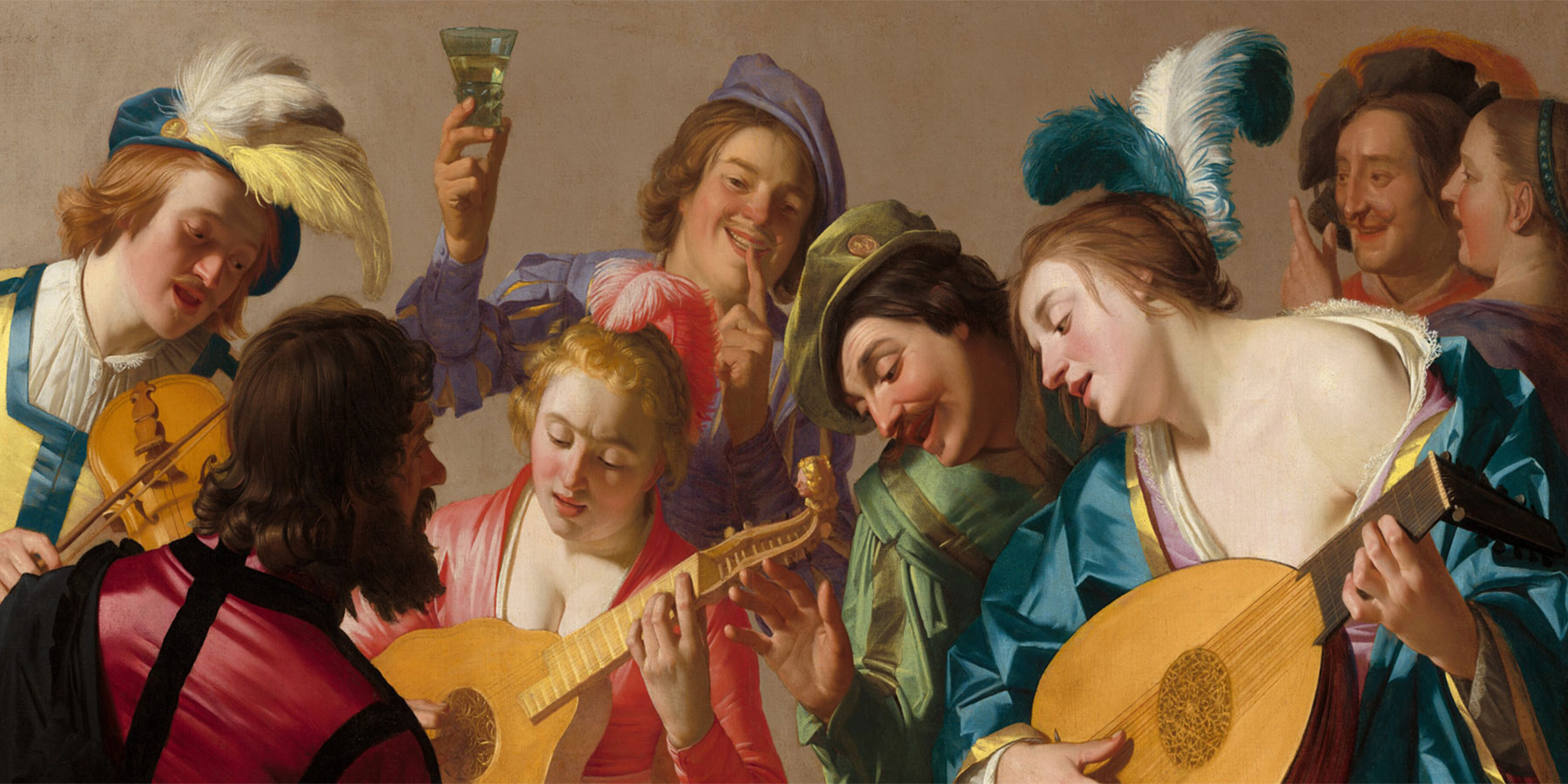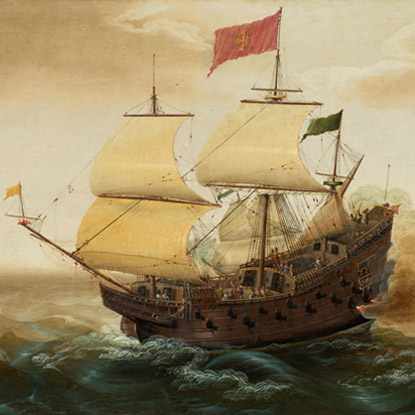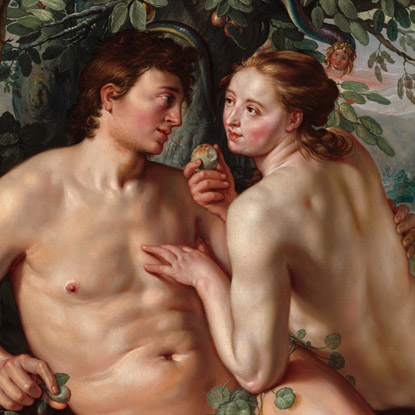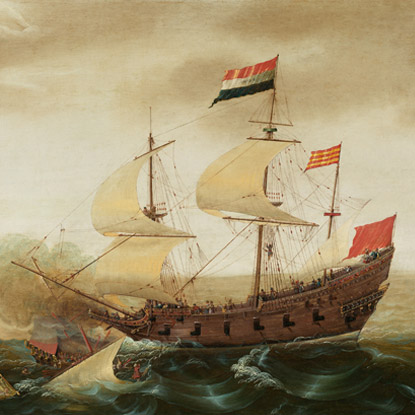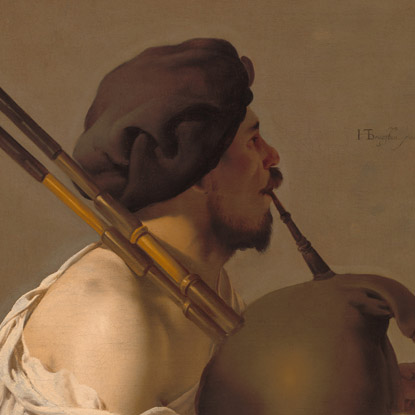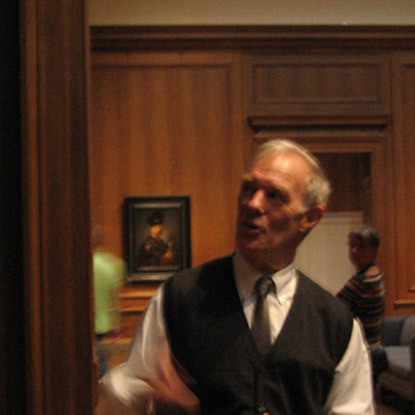Video/Audio on 17th-Century Dutch Paintings
Video highlights
All Related Videos
Getting to Know the Dutch Paintings Collection
Curator Arthur K. Wheelock Jr. introduces the collection of seventeenth-century Dutch paintings at the National Gallery of Art. Filmed in the elegant oak-paneled galleries where the Dutch paintings hang, Wheelock discusses the collection’s history and changing character since the Gallery was founded in 1941.
The Dutch and Flemish Cabinet Galleries
Many seventeenth-century Dutch and Flemish paintings are small because they were created for domestic settings. In 1995 the National Gallery of Art unveiled the Dutch and Flemish Cabinet Galleries, a suite of intimately scaled, wood-paneled rooms that emulates the viewing experience one might have had in such an environment. Curator Arthur K. Wheelock Jr. tours the cabinet galleries, discusses his inspiration for them, and explains why they are especially appropriate for paintings such as Vermeer’s remarkable genre scenes.
A Painting’s History: Cuyp’s River Landscape with Cows
Many of the Dutch paintings at the National Gallery of Art have fascinating histories. Curator Arthur K. Wheelock Jr. recounts how, under the threat of the Third Reich, the Petschek family in Aussig (now the Czech Republic) saved their beautiful landscape by Albert Cuyp from the Nazis. Wheelock also relates the peaceful, Arcadian quality of Cuyp’s paintings to the political and social ideals of the Dutch Republic in the seventeenth century.
North Meets South: Goltzius and Rubens
By examining the stylistic relationships between two paintings in the National Gallery of Art, The Fall of Man by Hendrik Goltzius and Daniel and the Lions’ Den by Peter Paul Rubens, curator Arthur K. Wheelock Jr. explains how Goltzius drew inspiration from the great Flemish master. In 1612 Rubens traveled from Antwerp to Haarlem to visit Goltzius, and as The Fall of Man (1616) demonstrates, that meeting had a profound impact on Goltzius’ subsequent style.
Rembrandt’s The Mill
The dramatic composition and emotional power of Rembrandt’s The Mill has made it one of the most renowned paintings in the Dutch collection at the National Gallery of Art. Curator Arthur K. Wheelock Jr. takes viewers through the fascinating history of this masterpiece, which includes major controversies about its attribution and its appearance.
Rembrandt
Rembrandt van Rijn’s art is marked by his ability to capture the human experience in its joys, its drama, and its vulnerabilities. His many self-portraits are among the most iconic of his works. Curator Arthur K. Wheelock Jr. explains how Rembrandt, in his Self-Portrait of 1659, depicted himself as a proud and thoughtful individual, worn with age but with an inner dignity gained from the personal difficulties he had experienced in the mid-1650s.
"The Maas at Dordrecht," c. 1650, Aelbert Cuyp
"Vase of Flowers," c. 1660, Jan Davidsz de Heem
"The Mill," 1645/1648, Rembrandt van Rijn
"Banquet Piece with Mince Pie," 1635, Willem Claesz Heda
"Forest Scene," c. 1655, Jacob van Ruisdael
"Portrait of a Merchant," c. 1530, Jan Gossaert
"The Dancing Couple," 1663, Jan Steen
"Self-Portrait," 1659, Rembrandt van Rijn
"Self-Portrait, c. 1630," Judith Leyster
Verbeeck's Battle: Restoring War in the Conservation Lab
At the time of their acquisition in 1995, Cornelis Verbeeck's paintings Dutch Warship Attacking a Spanish Galley and Spanish Galleon Firing Its Cannons were covered with layers of discolored varnish. Their sojourn in the conservation lab, however, revealed a complex story that transformed our understanding of these paintings. Arthur Wheelock, curator of northern baroque paintings, is joined by Michael Swicklik, senior conservator, and Richard Ford, frame conservator, as they discuss this exciting discovery, and the paintings' new appearance as two halves of a reunited battle scene.
Vermeer: In the Light of Delft
Vermeer's classic painting A Lady Writing inspired this evocative film. The exquisite skills of this 17th-century Dutch artist evoke nuances of light, texture, and reflection that describe both the artist's native city of Delft and the details of this much-loved work. Painted ermine, pearls, velvet, brass, and wood are illuminated by the sensitive touch of an unparalleled master.
Audio highlights
All Related Audio
The Girl with a Pearl Earring: The Making of an Icon
Arthur K. Wheelock Jr., curator of northern baroque paintings, National Gallery of Art. At the end of the 19th century, Johannes Vermeer’s Girl with a Pearl Earring sold for a pittance, an unknown work by an artist who was only beginning to achieve recognition. Today it is revered as a great masterpiece, so famous that it is recognizable by its title alone, with the name of its maker being almost superfluous. In this lecture recorded on June 1, 2014, at the National Gallery of Art, curator Arthur Wheelock examines the reasons why this image resonates so profoundly with contemporary audiences.
Paintings in a New Age: The Debut of NGA Online Editions
Arthur K. Wheelock Jr., curator of northern baroque paintings, National Gallery of Art. The National Gallery of Art houses one of the most celebrated collections of Dutch paintings in the world. Over the past several years, the Gallery has been updating its out-of-print catalogue of 17th-century Dutch paintings in preparation for publishing it anew online. In this lecture recorded on March 23, 2014, at the National Gallery of Art, this, the inaugural publication in the Gallery’s Online Editions series, is discussed and demonstrated by the Gallery’s curator of northern baroque paintings, and the curatorial, technical, and publishing team behind this innovative program initially funded by the Getty Foundation.
The Education of a Curator: Keeping It All in Balance
Arthur J. Wheelock Jr., curator of northern baroque paintings, National Gallery of Art In 1975 Arthur K. Wheelock Jr. was appointed curator of northern baroque paintings at the National Gallery of Art. During his nearly 40 years in the position, Wheelock has cared for, cultivated, and strengthened the Dutch and Flemish paintings collection. He has also fostered an impressive exhibition program, including Anthony van Dyck (1990), Johannes Vermeer: The Art of Painting (1999), Rembrandt’s Late Religious Portraits (2005), Jan Lievens: A Dutch Master Rediscovered (2008), and Judith Leyster (1609-1660) (2009). In this lecture recorded on December 15, 2013, Wheelock shares the history of the Dutch and Flemish collection and special exhibitions while looking toward the future of curatorial responsibility.
Introduction to the Exhibition- "Elegance and Refinement: The Still-Life Paintings of Willem van Aelst"
Arthur K. Wheelock Jr., curator of northern baroque paintings, National Gallery of Art, and Melanie Gifford, research conservator, National Gallery of Art. Few artists were more skilled than Willem van Aelst (1627-1683) at depicting luscious fruits, luxurious fabrics, and spoils of the hunt. His renowned still lifes are remarkable for their fine finish, carefully balanced composition, jewel-toned palette, and elegant subject matter. Bringing together 28 of these sumptuous paintings and his only known drawing, this exhibition- the first devoted solely to this artist- celebrates the most technically brilliant Dutch still-life painter of his time. It is also accompanied by the first comprehensive publication on his work. In this opening day lecture, curator Arthur K. Wheelock Jr. discusses van Aelst's life and talent, including his impact on late-17th-century still-life painting. Conservator Melanie Gifford discusses the technical research that revealed how van Aelst created his luxurious illusions. Elegance and Refinement: The Still-Life Paintings of Willem van Aelst is on view at the National Gallery of Art from June 24 to October 14, 2012.
Meeting Metsu: ANOTHER Dutch Master
Arthur K. Wheelock Jr., curator of northern baroque paintings, National Gallery of Art; Pieter Roelofs, curator of 17th-century paintings, Rijksmuseum; and Adriaan E. Waiboer, curator of northern European art, National Gallery of Ireland. Curators Arthur Wheelock, Pieter Roelofs, and Adriaan E. Waiboer discuss the paintings of Dutch artist Gabriel Metsu. A contemporary of Johannes Vermeer, Metsu had the ability to capture ordinary moments in 17th-century Dutch life with sensitivity and realism. Recorded on April 22, 2011, this lecture was held in conjunction with the exhibition Gabriel Metsu, 1629-1667, on view at the National Gallery of Art from April 10 to July 24, 2011
Gabriel Metsu, 1629-1667
Arthur K. Wheelock Jr., curator, northern baroque paintings, National Gallery of Art, Washington, and Pieter Roelofs, curator of 17th-century paintings, Rijksmuseum, Amsterdam. One of the leading painters of 17th-century Holland and a contemporary of Johannes Vermeer, Gabriel Metsu was a gifted visual storyteller who infused his narrative paintings with suspense, drama, and emotion. On the occasion of the first monographic exhibition of Metsu's work in the United States, Wheelock talks with Roelofs about the artist's ability to capture ordinary moments with spontaneity and unerring realism.
Press Event: Gabriel Metsu, 1629-1667
In the first monographic exhibition of Gabriel Metsu's work in the United States, 33 paintings reveal the artist's extraordinary ability to capture ordinary moments of 17th-century Dutch life with spontaneity and unerring realism. On view in the East Building of the National Gallery of Art, Washington, from April 10 through July 24, 2011, 'Gabriel Metsu, 1629–1667' includes 14 paintings that have never been on view in the U.S.
Jan Lievens: Out of Rembrandt's Shadow; Jan Lievens in Black and White: Etchings, Woodcuts, and Collaborations in Print
Arthur K. Wheelock Jr., curator of northern baroque paintings, National Gallery of Art, and Stephanie S. Dickey, Bader Chair in Northern Baroque Art, Queen's University. Recorded on October 26, 2008, this podcast celebrates the major international loan exhibition Jan Lievens: A Dutch Master Rediscovered, which was on view at the National Gallery of Art from October 26, 2008, to January 11, 2009. In the first of two lectures, Arthur Wheelock places Lievens in historical context—particularly in relationship to his friend and colleague from Leiden, Rembrandt van Rijn—and focuses on the evolution and character of Lievens' paintings. In the second lecture, Stephanie Dickey examines Lievens' remarkable achievements as a printmaker.
Dutch Paintings at the National Gallery of Art: The Untold Stories behind the Acquisitions of the Rembrandts, Vermeers, and Other Treasures in the Collection
Arthur K. Wheelock Jr., curator of northern baroque paintings, National Gallery of Art. In this podcast recorded on November 28, 2010, at the National Gallery of Art, Arthur Wheelock reveals the provenance of various Dutch masterpieces that hang in the West Building galleries. Wheelock explores the growth of the Dutch collection from the time the Gallery opened in 1941 to the present day, when it is considered one of the most celebrated collections of Dutch paintings in the world.
Hendrick Avercamp: The Little Ice Age: Part 2, One Community on the Ice
Arthur K. Wheelock Jr., curator, northern baroque painting, National Gallery of Art, Washington, and Bianca du Mortier, curator of costume, Rijksmuseum, Amsterdam. In the second of this two-part podcast series, produced on the occasion of the first exhibition dedicated to Avercamp, Arthur Wheelock talks with curator Bianca du Mortier about Avercamp's 17th-century theatrical settings on ice, which not only depict a tremendous diversity of subjects but also record daily life during the Dutch Golden Age.
Hendrick Avercamp: The Little Ice Age: Part 1, Winter Landscapes
Arthur K. Wheelock Jr., curator, northern baroque painting, National Gallery of Art, Washington, and Pieter Roelofs, curator of 17th-century paintings, Rijksmuseum, Amsterdam. The vibrant and colorful paintings of Hendrick Avercamp transport us back to a time when Dutch rivers and waterways regularly froze in the cold of winter. In the first of this two-part podcast series, produced on the occasion of the first exhibition dedicated to Avercamp, Arthur Wheelock talks with curator Pieter Roelofs about Avercamp's winter landscapes, which bring to life the lively pastimes and day-to-day bustle of the Golden Age of the Dutch Republic.
Hendrick ter Brugghen's "Bagpipe Player"
Arthur K. Wheelock Jr., curator, northern baroque painting, National Gallery of Art, Washington. Dutch artist Hendrick ter Brugghen (1588-1629) is the most important of the Utrecht Caravaggisti, artists who traveled to Rome in the early decades of the 17th century, and who returned to Utrecht having embraced the radical stylistic and thematic ideas of Caravaggio. In this podcast produced on the occasion of a new acquisition, Wheelock talks to host Barbara Tempchin about Ter Brugghen's Bagpipe Player, the first painting of this stylistic group to enter the Gallery's collection.
Judith Leyster, 1609-1660: Part 4, Music in the Paintings of Judith Leyster
Arthur K. Wheelock Jr., curator, northern baroque paintings, National Gallery of Art, Washington; Kenneth Slowik, artistic director, Smithsonian Chamber Music Society, and curator of musical instruments, Smithsonian Institution. Dutch artist Judith Leyster's 400th birthday is celebrated at the Gallery with an exhibition of 10 of her most engaging paintings, joined by some 20 paintings, works on paper, and musical instruments of the period. In the fourth podcast produced on the occasion of the exhibition, Wheelock talks to Ken Slowik about Leyster's love of music, the instruments she depicted, and various musical compositions of the age.
Judith Leyster, 1609-1660: Part 3, Music in Leyster's Work
Arthur K. Wheelock Jr., curator of northern baroque painting, National Gallery of Art, Washington, and Frima Fox Hofrichter, professor of the history of art and design, Pratt Institute, New York. Dutch artist Judith Leyster's 400th birthday is celebrated at the Gallery with an exhibition of 10 of her most engaging paintings, joined by some 20 works by 17th-century contemporaries, as well as musical instruments of the period depicted in the art. In the last of this three-part podcast, produced on the occasion of the exhibition, Wheelock talks to Leyster scholar Frima Fox Hofrichter about the important recurring theme of music in Leyster's work.
Judith Leyster, 1609-1660: Part 2, Leyster's Technique
Arthur K. Wheelock Jr., curator of northern baroque painting, National Gallery of Art, Washington, and Frima Fox Hofrichter, professor of the history of art and design, Pratt Institute, New York. Dutch artist Judith Leyster's 400th birthday is celebrated at the Gallery with an exhibition of 10 of her most engaging paintings, joined by some 20 works by 17th-century contemporaries, as well as musical instruments of the period depicted in the art. In the second of this three-part podcast, produced on the occasion of the exhibition, Wheelock talks to Leyster scholar Frima Fox Hofrichter about Leyster's innovative painting technique and highly engaging compositions.
Judith Leyster, 1609-1660: Part 1, An Introduction
Arthur K. Wheelock Jr., curator of northern baroque painting, National Gallery of Art, Washington, and Frima Fox Hofrichter, professor of the history of art and design, Pratt Institute, New York. Dutch artist Judith Leyster's 400th birthday is celebrated at the Gallery with an exhibition of 10 of her most engaging paintings, joined by some 20 works by 17th-century contemporaries, as well as musical instruments of the period depicted in the art. In the first of this three-part podcast, produced on the occasion of the exhibition, Gallery curator Arthur Wheelock talks to Leyster scholar Frima Fox Hofrichter about the range of Leyster's work, beginning with her renowned Self-Portrait, c. 1632-1633, from the Gallery's permanent collection.
Press Event: Judith Leyster, 1609 - 1660
Judith Leyster's 400th birthday will be celebrated at the National Gallery of Art with an exhibition of ten of her most engaging paintings, joined by some 20 works by 17th-century contemporaries, including her presumed teacher Frans Hals and her husband Jan Miense Molenaer, as well as musical instruments of the period depicted in the art. 'Judith Leyster, 1609–1660' will be on view from June 21 through November 29, 2009, in the Dutch Cabinet Galleries in the Gallery's West Building.
Pride of Place, Part 3: Daily Life
Arthur K. Wheelock Jr., curator of northern baroque paintings, National Gallery of Art. The Dutch took enormous pride in their cities, which experienced unprecedented prosperity during the 17th century. A new genre of painting-the cityscape-emerged as images of towns and cities were captured in paintings, maps, atlases, illustrated books, and prints. In the third of this three-part Backstory podcast, produced on the occasion of the Gallery exhibition Pride of Place: Dutch Cityscapes of the Golden Age, Wheelock discusses daily life as depicted in cityscapes, from inside the domestic courtyard and bustling city-centers to urban life seen from beyond.
Pride of Place, Part 2: The Cities
Arthur K. Wheelock Jr., curator of northern baroque paintings, National Gallery of Art. The Dutch took enormous pride in their cities, which experienced unprecedented prosperity during the 17th century. A new genre of painting-the cityscape-emerged as images of towns and cities were captured in paintings, maps, atlases, illustrated books, and prints. In the second of this three-part Backstory podcast, produced on the occasion of the Gallery exhibition Pride of Place: Dutch Cityscapes of the Golden Age, Wheelock talks about the cities of the seventeen Dutch provinces and the artists who depicted them.
Pride of Place, Part 1: The Cityscape
Arthur K. Wheelock Jr., curator of northern baroque paintings, National Gallery of Art The Dutch took enormous pride in their cities, which experienced unprecedented prosperity during the 17th century. A new genre of painting-the cityscape-emerged as images of towns and cities were captured in paintings, maps, atlases, illustrated books, and prints. In the first of this three-part Art Talk podcast, produced on the occasion of the Gallery exhibition Pride of Place: Dutch Cityscapes of the Golden Age, Wheelock discusses how Dutch politics and cartography influenced the cityscape.
Press Event: Pride of Place: Dutch Cityscapes in the Golden Age
Visitors will travel back in time to Dutch cities of the 17th century during 'Pride of Place: Dutch Cityscapes of the Golden Age,' on view February 1 through May 3, 2009, in the West Building, National Gallery of Art, Washington. The exhibition of 48 paintings and 23 maps, atlases, and illustrated books will offer a breathtaking survey of the Dutch cityscape, from wide-angle panoramas depicting the urban skyline with its fortifications, windmills, and church steeples, to renderings of daily life along the canals, in city streets, and in town squares.
Jan Lievens, Part 3: Return to the Netherlands (1644-1674)
Arthur Wheelock, curator of northern baroque painting, National Gallery of Art. Jan Lievens was a child prodigy, whose later career was marked by important civic and private commissions. Nevertheless, his name today barely registers in the public consciousness. In the third of this three-part Backstory podcast, produced on the occasion of the Gallery exhibition Jan Lievens: A Dutch Master Rediscovered, Wheelock talks about Lievens' success and legacy.
Jan Lievens, Part 2: London and Antwerp (1632-1644)
Arthur Wheelock, curator of northern baroque painting, National Gallery of Art. Jan Lievens was a child prodigy, whose later career was marked by important civic and private commissions. Nevertheless, his name today barely registers in the public consciousness. In the second of this three-part Backstory podcast, produced on the occasion of the Gallery exhibition Jan Lievens: A Dutch Master Rediscovered, Wheelock talks about changes in Lievens' style and the influence of Anthony Van Dyck.
Jan Lievens, Part 1: The Leiden Years (1620-1632)
Arthur Wheelock, curator of northern baroque painting, National Gallery of Art. Jan Lievens was a child prodigy, whose later career was marked by important civic and private commissions. Nevertheless, his name today barely registers in the public consciousness. In the first of this three-part Backstory podcast, produced on the occasion of the Gallery exhibition Jan Lievens: A Dutch Master Rediscovered, Wheelock talks about Lievens' early career and his relationship with Rembrandt.
Press Event: Jan Lievens: A Dutch Master Rediscovered
The life and career of Jan Lievens (1607–1674), one of the greatest yet most enigmatic Dutch painters of the 17th century, is finally brought to light in the exhibition 'Jan Lievens: A Dutch Master Rediscovered,' on view at the National Gallery of Art in the West Building from October 26, 2008, through January 11, 2009.
Going Dutch, Part 2: Exploring Paintings from the Netherlands
Arthur K. Wheelock Jr., curator of northern baroque paintings, National Gallery of Art. Why do so many people love Dutch paintings? Whether it is the stunning landscapes, the seemingly familiar portraits, or the lush still lifes, these centuries-old paintings still resonate today. In the second part of this Backstory episode, curator Arthur Wheelock and host Barbara Tempchin discuss the National Gallery of Art Dutch paintings collection, how it grew, and the recent acquisition of a Salomon van Ruysdael masterpiece.
Going Dutch, Part 1: Exploring Paintings from the Netherlands
Arthur K. Wheelock Jr., curator of northern baroque paintings, National Gallery of Art. Why do so many people love Dutch paintings? Whether it is the stunning landscapes, the seemingly familiar portraits, or the lush still lifes, these centuries-old paintings still resonate today. In the first part of this Backstory episode, curator Arthur Wheelock and host Barbara Tempchin discuss these masterpieces and why they continue to fascinate us.
